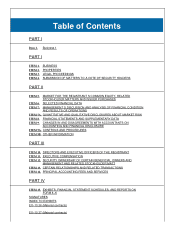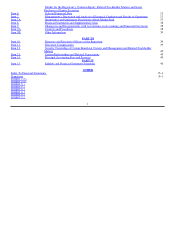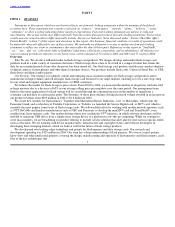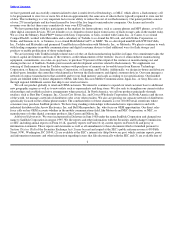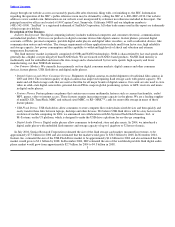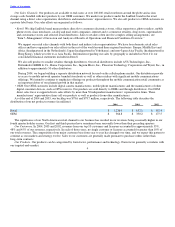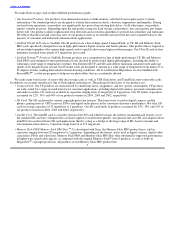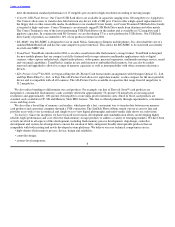SanDisk 2004 Annual Report Download - page 12
Download and view the complete annual report
Please find page 12 of the 2004 SanDisk annual report below. You can navigate through the pages in the report by either clicking on the pages listed below, or by using the keyword search tool below to find specific information within the annual report.
Table of Contents
• compact packaging; and
• low−cost system testing.
We have also initiated, defined and developed standards to meet new market needs and to promote wide acceptance of the
standards through interoperability and ease−of−use.
To achieve compatibility with various electronic platforms regardless of the host processors or operating systems used, we
developed new capabilities in flash memory chip design and created intelligent controllers. We also developed an architecture that can
leverage advances in process technology designed for scaleable, high−yielding, cost−effective and highly reliable manufacturing
processes. We design our products to be compatible with industry−standard interfaces used in standard operating systems for personal
computers, feature phones and smart phones, PDAs and other consumer and industrial products.
Our patented intelligent controller with its advanced defect management system permits our flash storage card products to achieve
a high level of reliability and longevity. Each one of our flash cards contains many millions of flash memory cells. For example, our 4
gigabyte cards may contain as many as 35 billion storage cells. A failure in any one of these cells or in a group or block of cells can
result in loss of data such as picture files, and this can occur several years into the life of a flash storage card. The controller chip
inside our cards is designed to detect such defects and recover data under most standard conditions.
Our research and development expenses were $125.0 million, $84.2 million and $63.2 million in 2004, 2003 and 2002,
respectively.
Patents and Licenses. We rely on a combination of patents, trademarks, copyright and trade secret laws, confidentiality procedures
and licensing arrangements to protect our intellectual property rights. See “Item 7−Factors That May Effect Future Results−We may
be unable to protect our intellectual property rights, which would harm our business, financial condition and results of operations.”
In 1988, we developed the concept of emulation of a hard disk drive with flash solid−state memory. The first related patents were
filed by our president and chief executive officer Dr. Eli Harari and exclusively licensed to us. As of the end of 2004, we owned or
had exclusive rights to approximately 279 United States patents, approximately 165 foreign patents, approximately 297 patent
applications pending in the United States, and have foreign counterparts pending on many of the applications in multiple jurisdictions.
We intend to seek additional international and United States patents on our technology.
We currently have patent license agreements with several companies including, among others, Intel Corporation, or Intel, Lexar
Media, Inc., or Lexar, Matsushita, Renesas, Samsung, Sharp Electronics KK, or Sharp, Sony and Toshiba. From time−to−time, we
have also entered into discussions with other companies regarding potential license agreements for our patents.
Trade secrets and other confidential information are also important to our business. We protect our trade secrets through
confidentiality and invention assignment agreements.
Supply Chain. Our supply chain is an important competitive advantage.
• Silicon Sourcing. All of our flash memory card products require silicon wafers for the memory components and the controller
components. The majority of our memory is supplied from the ventures with Toshiba and our Toshiba foundry relationship. This
represents captive supply and we are obligated to take the output from the ventures with Toshiba. See “— Ventures With
Toshiba.” To a lesser extent, we source memory on a foundry basis from Renesas and Samsung. We are guaranteed supply of
percentages of total output by each of Renesas and Samsung, but are not obligated to use the guaranteed supply until we give
them an order for future purchases. Our controller wafers are currently supplied by Tower Semiconductor Ltd., or Tower, and
United Microelectronics Corporation, or UMC. We have a foundry agreement with Tower and purchase from UMC on a
purchase order basis. See “Item 7−Factors That May Affect Future Results−We
7


